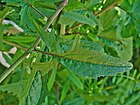Note: This is a project under development. The articles on this wiki are just being initiated and broadly incomplete. You can Help creating new pages.
Sisymbrium officinale - Hedge mustard
Hedge mustard is a plant in the family Brassicaceae. It is found on roadsides and wasteland, and as a weed of arable land. A native of Europe and North Africa, it is now well-established throughout the world.
Contents
- 1 Uses
- 2 Parts Used
- 3 Chemical Composition
- 4 Common names
- 5 Properties
- 6 Habit
- 7 Identification
- 8 List of Ayurvedic medicine in which the herb is used
- 9 Where to get the saplings
- 10 Mode of Propagation
- 11 How to plant/cultivate
- 12 Commonly seen growing in areas
- 13 Photo Gallery
- 14 References
- 15 External Links
Uses
loss of the voice, throat complaints, heart problems, common cold, remedy for gout, dampening effect on cough, bronchitis, Diarrhea, Sore throats
Parts Used
Chemical Composition
Isopropyl isothiocyanate (27.6-48.9%), 2-methylpropanenitrile (0.5-18.8%), (Z)-hex-3-en-1-ol (0.5-18.0%), sec-butyl isothiocyanate (4.9-9.4%), (E)-hex-2-enal (3.5-8.6%), (Z)-hex-2-en-1-ol (0.3-8.4%), octanoic (0.5-8.6%) and dodecanoic acid (0-5.0%), 2-methylbutanenitrile (0-4.6%), dibutyl phthalate (0-4.5%), and ethyl linolenate (0-3.6%).[1]
Common names
| Language | Common name |
|---|---|
| Kannada | |
| Hindi | |
| Malayalam | |
| Tamil | |
| Telugu | |
| Marathi | NA |
| Gujarathi | NA |
| Punjabi | NA |
| Kashmiri | NA |
| Sanskrit | |
| English | Hedge Mustard, wild mustard |
Properties
Reference: Dravya - Substance, Rasa - Taste, Guna - Qualities, Veerya - Potency, Vipaka - Post-digesion effect, Karma - Pharmacological activity, Prabhava - Therepeutics.
Dravya
Rasa
Tikta (Bitter), Kashaya (Astringent)
Guna
Laghu (Light), Ruksha (Dry), Tikshna (Sharp)
Veerya
Ushna (Hot)
Vipaka
Katu (Pungent)
Karma
Kapha, Vata
Prabhava
Habit
Identification
Leaf
| Kind | Shape | Feature |
|---|---|---|
| Simple | alternate | The leaves are compound i.e. made up of two or more discrete leaflets |
Flower
| Type | Size | Color and composition | Stamen | More information |
|---|---|---|---|---|
| Unisexual | 2-4cm long | Yellow | 5-20 | There are two or more ways to evenly divide the flower |
Fruit
| Type | Size | Mass | Appearance | Seeds | More information |
|---|---|---|---|---|---|
| General | 7–18 mm | the fruit is dry and splits open when ripe | many | {{{6}}} |
Other features
List of Ayurvedic medicine in which the herb is used
- Vishatinduka Taila as root juice extract
Where to get the saplings
Mode of Propagation
How to plant/cultivate
An easily grown plant, it succeeds in most soils but prefers a moist to dry acid to alkaline soil in full sun or light shade[3]
Commonly seen growing in areas
Hedge banks, uncultivated ground, waste ground.
Photo Gallery
References
External Links
- Ayurvedic Herbs known to be helpful to treat loss of the voice
- Ayurvedic Herbs known to be helpful to treat throat complaints
- Ayurvedic Herbs known to be helpful to treat heart problems
- Ayurvedic Herbs known to be helpful to treat common cold
- Ayurvedic Herbs known to be helpful to treat remedy for gout
- Ayurvedic Herbs known to be helpful to treat dampening effect on cough
- Ayurvedic Herbs known to be helpful to treat bronchitis
- Ayurvedic Herbs known to be helpful to treat Diarrhea
- Ayurvedic Herbs known to be helpful to treat Sore throats
- Herbs with Leaves used in medicine
- Herbs with Seeds used in medicine
- Herbs with common name in English
- Habit - Annual plant
- Index of Plants which can be propagated by Seeds
- Herbs that are commonly seen in the region of Hedge banks
- Herbs that are commonly seen in the region of uncultivated ground
- Herbs that are commonly seen in the region of waste ground
- Herbs






